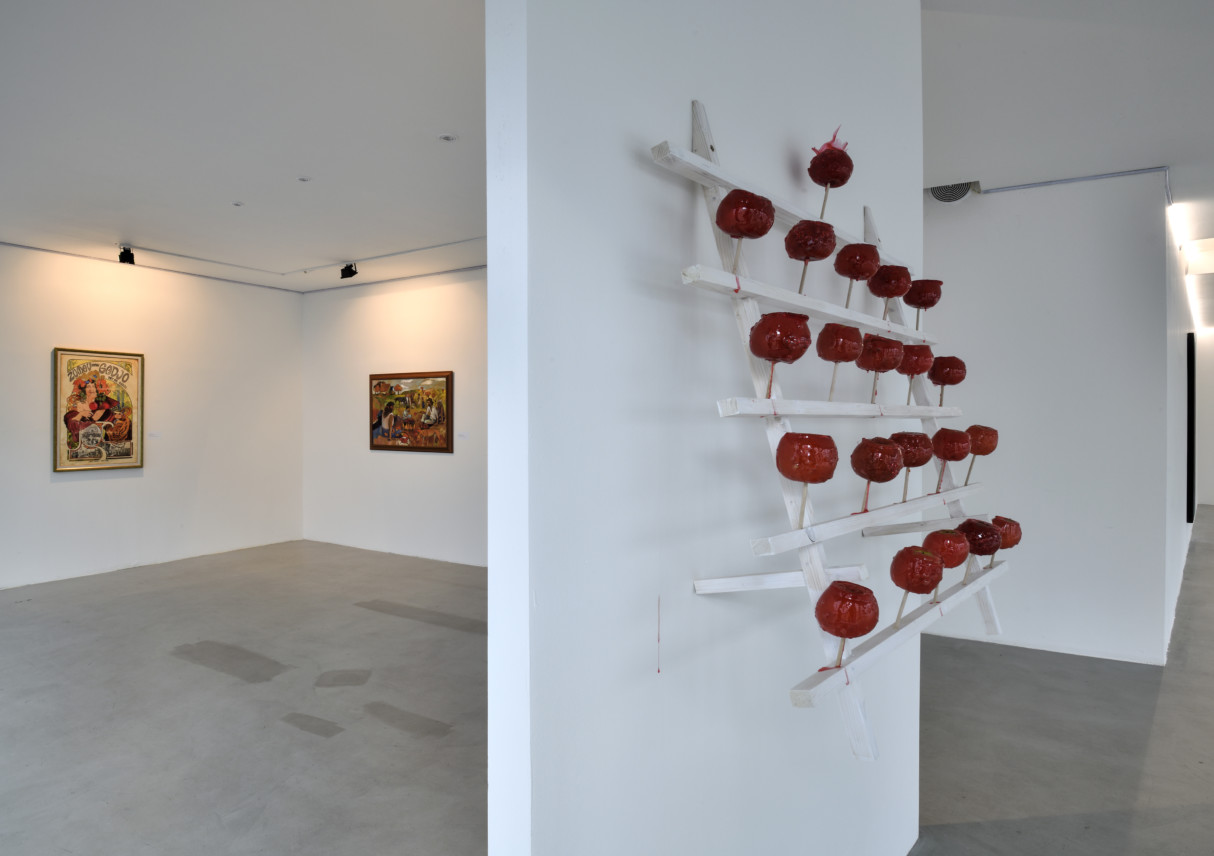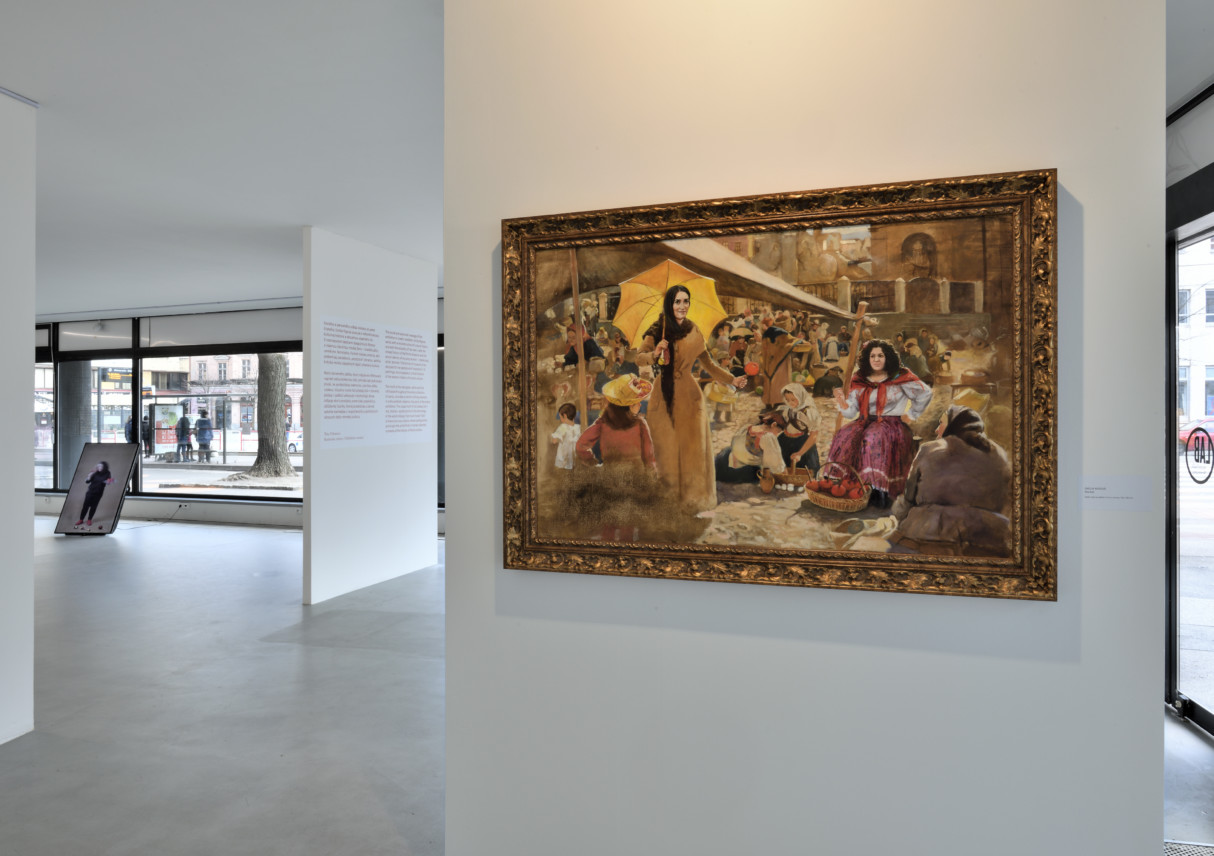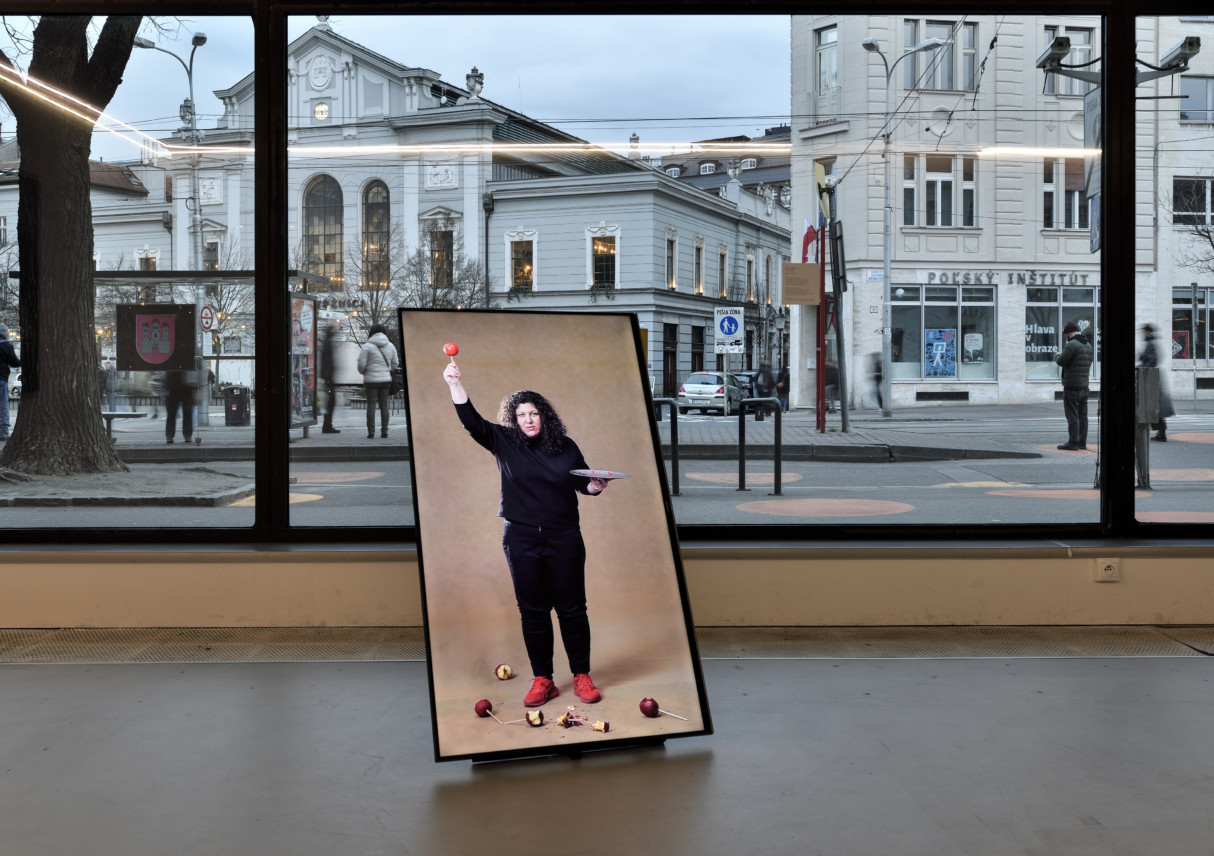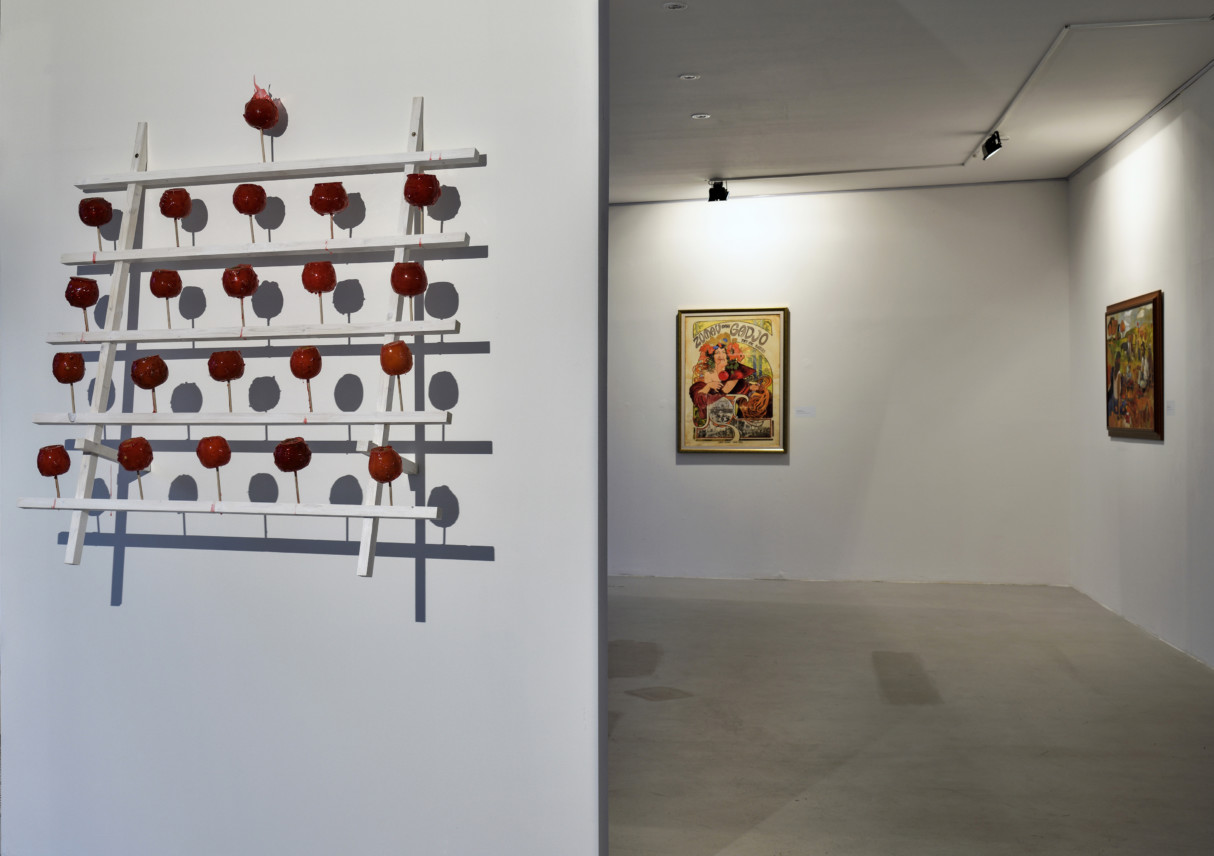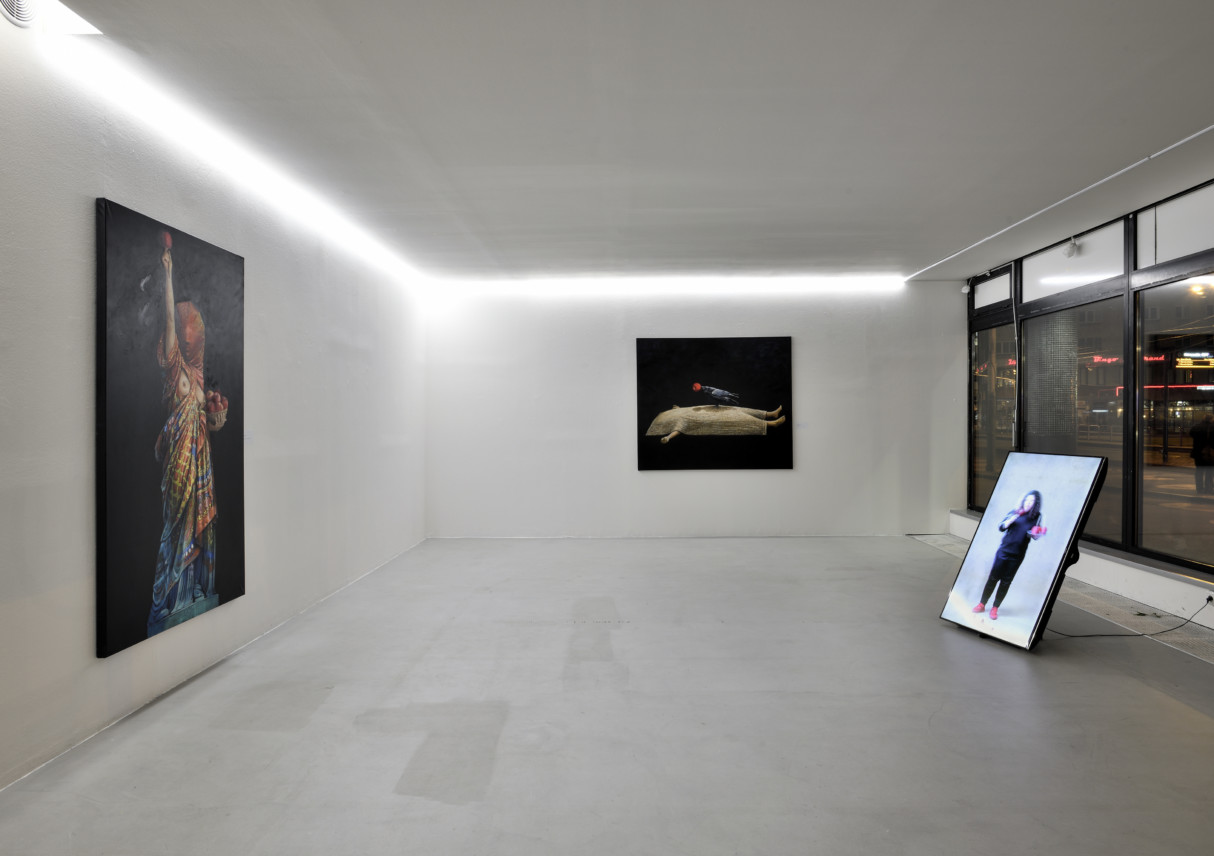Čohani z Koni Ajlend. After Bári Raklóri
The Witch from Coney Island
Towards an Archaeology of Roma Culture
At the end of 2018, Emília Rigová (*1980), winner of a by now traditional contest for artists under 40, was awarded the Oskár Čepan Award1, which is highly regarded in the art scene. Her work until then had been little known and thought about in Slovak art circles, and the contest itself, indeed, had been strikingly renewed and reorganised. From today’s perspective one must judge that the institutional and conceptual “refreshing” of the prize has been successful. Rigová’s activity on the wider European scene, as both artist and art expert, may furnish an example of this. Her solo exhibition in Kunsthalle LAB is a “laureate’s exhibition”, which in past times had been customarily arranged as part of the victor’s award. Kunsthalle Bratislava, in close cooperation with the Foundation – Centre for Contemporary Art, is resuming this tradition with Čohani z Koni Ajlend (The Witch from Coney Island), and we aim to develop it further.
In recent years this artist’s creative agenda has revolved round the issues of Roma identity and the concept of the Roma culture as such. Whether under her artistic name or as her alter ego Bári Raklóri (bári = big, raklóri = daughter of non-Roma parents), she has creatively and critically developed and posed these groups of issues. She uses this alter ego as a kind of personal code or narrative, via which she retrieves her individual experience and also the broader context of thinking about and knowing Roma culture. Indeed, besides her own visual production Rigová engages in numerous activities connected with educating the Roma minority, increasing their visibility, and researching their society and culture (and not only in Slovakia). From all of this one might single out the emergence, through her personal initiative, of the Cabinet of Roma Art and Culture at the University of Matej Bel in Banská Bystrica (2019), and her numerous activities involving the Berlin-based European Roma Institute for Culture and Art2 (since 2017).
Keeping this background in mind, whenever Rigová and her co-workers (whether from the contemporary art scene or the academic field) attempt to create supporting pillars for the knowledge and development of the Roma culture, one can distinguish the accent of activism in her work. Just as, for example, “women’s art”, feminism, or the queer agenda, pursued their emancipation in the context of art history and theory, likewise artists with Roma roots are now embarking upon this journey: reflections, visualisations, humanisations, acceptances in the field of professional visual art, and subsequently perhaps also a gradual blending and a possible abandonment of the Roma issues as their primary conceptual framework. In both individual and collective initiative we find, on the one hand, the positive ambition of making Roma artists more visible and making them part of the world of contemporary art; on the other hand, there is the paradoxical accompanying effect of severance in exhibitions which are thus ethnically defined.
Among the key group exhibition projects which unquestionably contributed to reinforcing and supporting the consideration of Roma identity in current visual art, one may count such exhibitions as The Universe is Black (Moravian Gallery, Brno, CZ, 2017 – 2018), Invisible Museum (tranzit.sk, Bratislava, SK, 2017 – 2018), Futuroma (Venice Biennale, Venice, IT, 2019), and the recent Keres Kultura! (Central Slovakian Gallery, Banská Bystrica, SK, 2019 – 2020), where Rigová was also involved in the planning and realisation of the project as co-curator. The examples given above create our current local and site-specific context for knowing and perceiving the work of professional artists with Roma roots and the issues which they emphasise. Apart from exhibitions and the above-mentioned institutional background, in Emília Rigová as Bári Raklóri there is also the striking influence of two equally successful visual artists and public figures, Tamara Moyzes and Robert Gabriš.
Rigová’s creative “background” has basically countervailing pressures, which add expressive force, authenticity, conviction, and also engagement, to her works. She herself comes from an assimilated family, where the cultivation of the Roma language as a basal cultural identifier had already been no more than a memory for some generations. The search for, uncovering of, and critical reflection upon, aspects of identity that are supremely Roma, has an archaeological character in her case. Via art she (de)composes herself anew and identifies herself as Bári Raklóri. And yet this is not a personal mythology or archaeology in the sense of “a Roma family tree”. Her approach to the question of Roma identity leads from the individual to the universal; through her own personal narrative she visualises the invisible and unknown. In her work the Roma, an object of majority perception, is transformed and “raised” into a subject who performs and emerges independently and masters the situation by means of the gaze.
One of this artist’s principal instruments for communication and for art, which is also a distinguishing feature of The Witch of Coney Island, is a subversion of the stereotyped perception of Roma culture by the majority society. In specific works this is principally effected via the character Bári Raklóri, who in a certain sense embodies the general context of the Roma ethnic group through her own unique experience (woman, daughter, artist, educated activist and initiator of projects, etc.). At the same time, visually there is frequent accentuation of elements and symbols which the majority society customarily associates with Romas society: gold and golden colour, passionate and unbridled red, dark (black) skin colour, a general cultural orientalism to the point of kitschiness, love of ornamentation, and also poverty, nomadism, and so on. As an example, let us mention just the suggestive performative act of vomiting liquid gold in the video Vomite ergo sum! (2018), and the Roma flower design on a heavy bulletproof vest in Bulletproof Culture (2018), known to viewers from the finalist’s exhibition for the Oskár Čepan Award.
The set of works by Rigová shown here in première, specially prepared by her for solo presentation in Kunsthalle LAB, was inspired by the cultural environment of New York. She visited and made acquaintance with that city during a two-month artist’s residence last year. The display concept is surprising, and so is the range of media in these works, where the classical hung painting is at first sight dominant. By comparison with the artist’s preceding work, what we find is rather the digital image, the manipulated photograph, object or installation, and also, the artist’s typical genre, video-performance. The exhibition as an entirety, including its architecture, is designed here as a sort of museum-of-art with reference to the memory, story or history of the Roma ethnic group and their culture. Rigová intentionally designs the form of the museum, so as declaratively to emphasise the absence of the relevant Roma history in general historical awareness. In Slovakia, for example, to this day there is no standard memorial institution3 that would map and make accessible the hitherto invisible history of Roma art and culture, which is almost unknown to us.
The artist wittily encodes the updated turn to the past, particularly in a trinity of smaller framed pictures which are a postmodern paraphrase of well-known modern artworks: by Paul Gauguin (Kotlárova Šej), Alfons Mucha (The Witch of Coney Island) and Dominik Skutecký (Market). She sifts through their visuality and transcribes it in a language that has an appearance of naive painting. Then, as a director in the background, she manipulates the content of the works with the aim of retrieving and visualising Roma history, which she thereby validates as a component of Euroamerican history. In paintings made on commission she deposits the Roma historical context via an explicit exchange of the original figures for Bári Raklóri, or for other Roma identities. The modern history of western culture, which is encoded here using familiar iconic images, thus undergoes a new reading and discursive interpretation (from the viewpoint of a woman, a Roma woman, and an artist of feminist orientation). Indeed, it is here that the subtitle of the exhibition is explained and takes on its proper significance.
The trinity of works functionally raises the museum-of-art impression and seeks to persuade the viewer of its own historical credibility. In a second reading, and looked at more closely, these works have a certain degree of amusing exaggeration (for example, the humorous incorporation of a well-known auctioneer in Market refers to the possible commodification of Roma culture). Also interesting here is the displacement of authorship, when Rigová conceptually directs and corrects the emergence and visuality of the images, while leaving their purport in a universal context. A question is thereby posed about the truthfulness of cultural and social history as we (epistematically) know them. She has chosen an identical approach in a further two of the paintings presented, which are distinguished by a more epic format and the absence of a frame. The architect of the exhibition, Peter Liška, has placed them at the opening and the conclusion, in such a way that they do after all fulfil their “matching” function. These figurative compositions, Hypnotic Poison and Havrana, are paradoxically more abstract in significance and shift the reading of the exhibition into wider connections.
In both of them Bári Raklóri “performs”, as an actor of corporeal and existential situations. The artist uses nudity and corporeality here in an allusive reference to visuality and the genres of historical painting, but about all as constitutive elements of her identity and self-recognition. Via the familiar, significantly loaded symbols of the snake and the raven, she opens up the mythicised dimension of Roma culture and provocatively tempts our archetypal consciousness. Both of these works are allusions to a sedimented cultural code and an idea of historical reality. Hypnotic Poison can be understood as a stylisation of the Roma woman as Eve, hence Bári Raklóri as the first Roma woman. Here also, Rigová ultimately brings alternative history into play and, with a characteristic measure of humour, opens up the question of credibility; she relativises wittily and asks for the origin and truth of her own identity. And although these works are not specifically prefigured in art history, they work very effectively on the allusive base of our consciousness of art and cultural archetypes.
The motif of the red apple, which we find infiltrated throughout the entire collection of works, provides a certain unifying element. It is the symbolic essence, the point of the entire exhibition. The visual motif of loli phabaj (loli = red, phabaj = apple) points to the etymology of the word lollipop, that much-loved “lolly” of American pop culture, whose prefiguration and origin the artist finds in certain silenced contexts of the history of Roma culture4. In Lady L. the statue of freedom is costumed in a typically decorative Roma headscarf with a feminist accent (emphasis on the femininity and politics of the artist’s body), while her customary attributes are exchanged for apples pierced on a rod (in Roma culture those were designed for roasting). The image is a symbolic personification and retrieval (correction) of the Roma starting-point of American popular culture. Together with the Loli phabay video performance, where the artist in her characteristic medium actively “crunches” confectionery, one may understand it also as a search for identity, a journey of finding oneself, of identifying oneself in an alien world.
Although the visual code of The Witch of Coney Island may come across as layered and diffuse, it is precisely the archetypal essentiality of the symbol of the red apple, and also the museum framework, that unites and rounds off the presentation of Emília Rigová’s art. She works in a sophisticated way with a strategy of archaeological research; she attaches findings from the etymology of the Roma language; she refreshes and reinterprets the structure of cultural symbols, aiming to visualise the Roma culture that is non-present in our history. With a characteristic degree of exaggeration and humour, she lightens the weight of the alternative / invisible Roma history, to which western society unquestionably owes a real debt. As a means of communication and construction of these themes she uses the personalised narrative Bári Raklóri, which from the unwritten history of Roma culture passes over to questions of individual identity, and vice versa. With the instruments of postproduction the artist stage-manages the emergence and visuality of simulacra: images as witnesses of the time, fictive records of the story of The Witch of Coney Island.
Nina Vrbanová
Exhibition curator
– – –
Footnotes:
1 The Oskár Čepan Award was established in 1996. Since 2001 it has been organised by the Foundation – Centre for Contemporary Art, currently in cooperation with the collective platform for the support of art. The prize is part of the YVAA – Young Visual Artists Award international network of awards (www.yvaawards.org), organised in the countries of east-central Europe.
2 ERIAC – European Roma Institute For Arts And Culture (www.eriac.org).
3 In 2002, at the Slovak National Museum at Martin, the ethnographically conceived Museum of the Culture of the Roma in Slovakia was established. In 2004 it opened a permanent exhibition, Romano Drom / Path of the Roma.
4 The term “lollipop” was recorded by the English lexicographer Francis Grose in 1796. It may be derived from the expressions “lolly” (tongue) and “pop” (slap). The first mentions of the lollipop in a modern context are from the 1920s. Alternatively, it may be a word of Roma origin, connected with the Roma tradition of selling apples wrapped in caramel at the fairs.
– – –
EMÍLIA RIGOVÁ (*1980, Trnava, Slovakia) is a visual artist working primarily with the object in the context of installation, performance, and site-specific interventions. She uses the possibilities of the 2D image, as computer graphics with its starting points in classical painting. The content of her work is an exploration of the intersubjectivity of emotional experience, modified by the specifics of the socio-cultural environment. Her central themes are cultural and social stereotypes, alter ego, the Roma identity, and the psychology of the individual. Emília Rigová studied in the Department of Sculpture at the Academy of Arts in Banská Bystrica, where in 2011 she was awarded a PhD. for her work Sculpture as Metalepsy in the Digital Age. Her activities include exhibition, curatorship, education and publishing. She teaches art courses in the fields of sculpture, multimedia and intermedia in the Department of Fine Arts at the Faculty of Education in Matej Bel University in Banská Bystrica, where she lives and works. She exhibits her work in Slovakia and also, intensively, abroad. Of her solo exhibitions we may mention Icons of the Periphery (2019) in Bratislava’s Gandy Gallery; Lost Forest (2018) in Berlin‘s ERIAC (The European Roma Institute for Arts and Culture); Lost Identity (2018) in MQ21 co in Vienna, among others. Group projects where she has exhibited include FUTUROMA (2019) at last year’s Biennale in Venice (curator Daniel Baker). With Petra Hanáková she was co-curator in the Central Slovakian Gallery in Banská Bystrica for Keres Kultura! / We’re Making Culture! (2019 – 2020). In 2018, she won the Oskár Čepan Award.
emiliarigova.com
– – –
NINA VRBANOVÁ (*1986, Bojnice, Slovakia) is curator and contemporary art critic. She graduated from the Institute of Literary and Artistic Communication at Constantine the Philosopher University in Nitra and the Faculty of Philosophy of Charles University in Prague. Between 2009 and 2013, she worked as a project manager and curator for the Cyprián Majerník Gallery in Bratislava. Until 2014, she worked as editor of Rider – Print of The Contemporary Art Movement Wall Gazzete. She is a member of the Slovak Section of the International Association of Critics AICA. Since 2014, she has worked in Kunsthalle Bratislava as curator, and currently as its appointed director / chief curator. Between 2010 and 2016, she completed her PhD in aesthetics at the Faculty of Philosophy at Constantine the Philosopher University in Nitra (the theme of her dissertation thesis was “Public Privacy. Semiotic of Visual Phenomena”). She is primarily engaged in developing concepts, in the implementation of curatorial exhibitions as well as in the critical reflection of current trends in visual arts (not only) in Slovakia. Occasionally she publishes in domestic and international professional periodicals and writes reviews on diploma and dissertation theses of artists. She is the founding director of Kunsthalle Bratislava as an independent state-contributory organization of the Ministry of Culture of the Slovak Republic.
– – –





